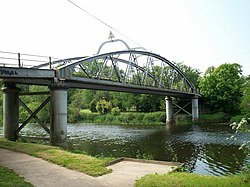Clonmore: Difference between revisions
Jump to navigation
Jump to search
Created page with '{{Infobox town |name=Clonmore |county=Armagh |picture= |picture caption= |os grid ref=H8860 |LG district=Dungannon }} '''Clonmore''' is a village in County Armagh. {{stub}}' |
No edit summary |
||
| (One intermediate revision by the same user not shown) | |||
| Line 2: | Line 2: | ||
|name=Clonmore | |name=Clonmore | ||
|county=Armagh | |county=Armagh | ||
|picture= | |picture=Bond's Bridge, Derrygally Road - geograph.org.uk - 814616.jpg | ||
|picture caption= | |picture caption=Bond's Bridge, Clonmore | ||
|os grid ref= | |os grid ref=H881603 | ||
|LG district= | |latitude=54.4833333 | ||
|longitude=-6.6408333 | |||
|population= | |||
|census year= | |||
|post town= | |||
|postcode= | |||
|dialling code= | |||
|LG district= | |||
|constituency= | |||
|townland=yes | |||
}} | }} | ||
'''Clonmore''' is a | '''Clonmore''' is a hamlet and townland in [[County Armagh]], close to the banks of the [[River Blackwater, County Armagh|River Blackwater]]. | ||
{{ | The name of the place is from the Irish ''Cluain Mór'', meaning 'Large meadow'.<ref>{{placenamesNI|9848|Clonmore}}</ref> | ||
==History== | |||
===Clonmore shrine=== | |||
The Clonmore shrine was found on the banks of the Blackwater River, which runs along the great meadow giving the townland its name. This shrine is said to be Ireland's earliest Christian metal artefact. It is housed today in the [[Ulster Museum]] in [[Belfast]].<ref>{{cite web |last=|first=|title=The Clonmore shrine |url=http://www.ulstermuseum.org.uk/look-and-learn/highlights/show/28/11/ |accessdate=2007-10-22 }}</ref> | |||
===Former railway=== | |||
In 1858 the Portadown, Dungannon and Omagh Junction Railway opened Vernersbridge railway station, hald a mile south of Clonmore.<ref name=FitzGerald>{{cite book |last=FitzGerald |first=J.D. |year=1995 |series=Colourpoint Transport |title=The Derry Road |volume=2 |location=Gortrush |publisher=Colourpoint Press |isbn=1-898392-09-9 |page=2}}</ref> The Great Northern Railway Board closed the station in 1954<ref name=FitzGerald/> and the Ulster Transport Authority closed the railway in 1965.<ref>{{cite book |last=Baker |first=Michael H.C. |authorlink=|year=1972 |title=Irish Railways since 1916 |location=London |publisher=Ian Allan |isbn=978-0-7110-0282-1 |pages=155, 209}}</ref> | |||
==Sport== | |||
*Gaelic football: Clonmore Robert Emmet's GFC | |||
*Ladies' Gaelic football: Naomh Labhaoise | |||
==Outside links== | |||
{{commons|Clonmore, County Armagh}} | |||
*[http://www.clonmore.net Clonmore,net] | |||
==References== | |||
{{reflist}} | |||
Latest revision as of 13:43, 30 November 2022
| Clonmore | |
| County Armagh | |
|---|---|
 Bond's Bridge, Clonmore | |
| Location | |
| Grid reference: | H881603 |
| Location: | 54°28’60"N, 6°38’27"W |
| Data | |
| Local Government | |
Clonmore is a hamlet and townland in County Armagh, close to the banks of the River Blackwater.
The name of the place is from the Irish Cluain Mór, meaning 'Large meadow'.[1]
History
Clonmore shrine
The Clonmore shrine was found on the banks of the Blackwater River, which runs along the great meadow giving the townland its name. This shrine is said to be Ireland's earliest Christian metal artefact. It is housed today in the Ulster Museum in Belfast.[2]
Former railway
In 1858 the Portadown, Dungannon and Omagh Junction Railway opened Vernersbridge railway station, hald a mile south of Clonmore.[3] The Great Northern Railway Board closed the station in 1954[3] and the Ulster Transport Authority closed the railway in 1965.[4]
Sport
- Gaelic football: Clonmore Robert Emmet's GFC
- Ladies' Gaelic football: Naomh Labhaoise
Outside links
| ("Wikimedia Commons" has material about Clonmore) |
References
- ↑ Clonmore - Placenames NI
- ↑ "The Clonmore shrine". http://www.ulstermuseum.org.uk/look-and-learn/highlights/show/28/11/. Retrieved 2007-10-22.
- ↑ 3.0 3.1 FitzGerald, J.D. (1995). The Derry Road. Colourpoint Transport. 2. Gortrush: Colourpoint Press. p. 2. ISBN 1-898392-09-9.
- ↑ Baker, Michael H.C. (1972). Irish Railways since 1916. London: Ian Allan. pp. 155, 209. ISBN 978-0-7110-0282-1.
